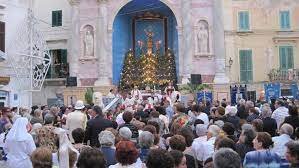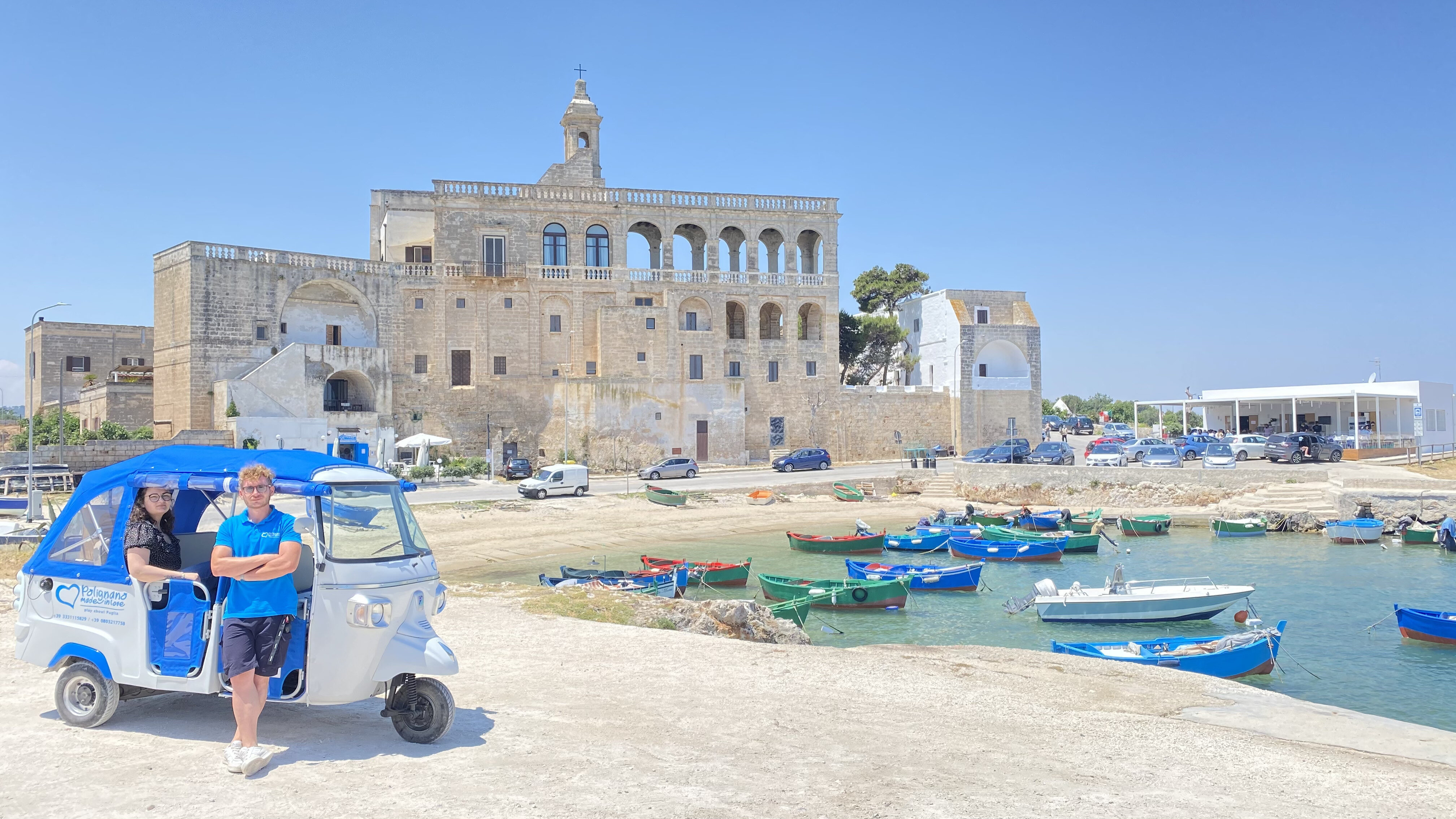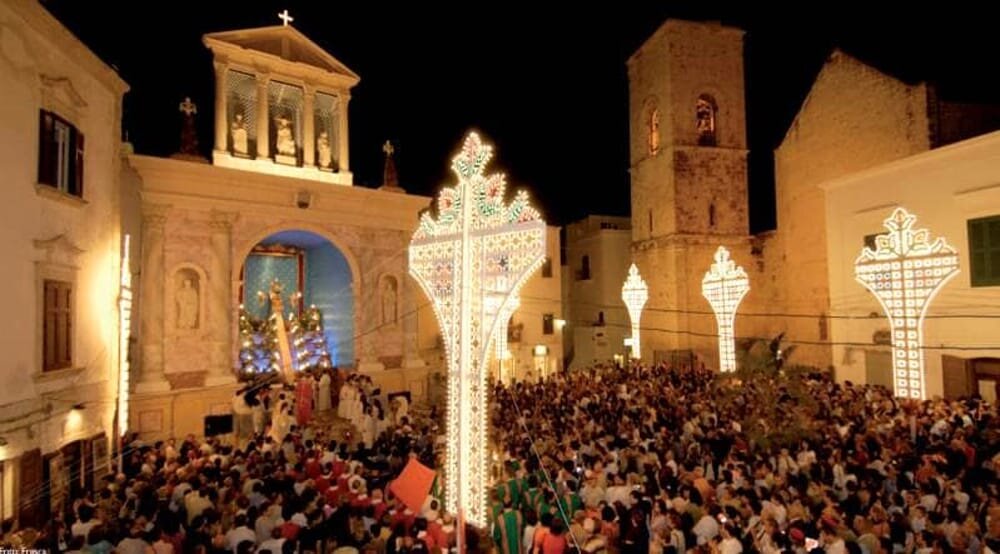San Vito was born in 286 in Mazara del Vallo in Sicily, to a wealthy family of the town; his father Iles, a pagan, was left a widower and entrusted him to a Christian nurse named Crescenzia, who, together with her husband Modesto, had the child baptized without his father's knowledge. Raised in the principles of the Christian faith, at a young age he was returned to his father, who committed himself heart and soul to making his son abandon the faith, even going so far as to denounce him to the prefect Valerian, who imprisoned and tortured him in an attempt to persuade him to worship the gods, but without any result.



Fearing for their lives, Crescenzia, Modesto, and Vito fled together and after days of sailing landed on the promontory of Capo Egitarso (now Capo San Vito), where they began to preach the gospel and Vito performed several miracles, but despite this, his work did not achieve the hoped-for success; in fact, they were forced to leave the town, whose inhabitants were punished by a violent landslide that buried the village. Fleeing once again, the three wandered throughout Sicily, preaching the gospel and performing wonders and healings. The fame of Vito and his thaumaturgic powers soon reached Emperor Diocletian, who, although a persecutor of Christians, asked the saint for help to free his son from the demon, afflicted by Chorea, also known as "Saint Vitus' dance." Once Diocletian had made use of Vito's powers, instead of rewarding him, he imprisoned him and, together with Modesto and Crescenzia, threw him to the lions; having survived, they were immersed in a cauldron of molten lead and the three miraculously emerged unharmed once again. They obtained the palm of martyrdom after being subjected on June 15, 299, to the "catasta," a torture that crushed the bodies of the victims. But how did the tradition of San Vito arrive in Polignano? After the martyrdom, a pious matron named Fiorenza, caught in a storm on the Sele river, asked God for help, who sent San Vito to her aid. The princess, to thank the saint, decided to give a proper burial to him and his companions in a "locus marianus" as requested by San Vito himself. Fiorenza ordered her men to search for this mysterious place, without any result. The princess, now resigned, decided to bury the three bodies where she had found them. After some time her brother fell ill and, in her grief, she again asked God for help; San Vito appeared to her in a dream and told her that he would heal her brother if she buried him, Modesto, and Crescenzia in the "locus marianus." Awakened from sleep, Fiorenza found before her a young doctor who asked her, in exchange for her brother's healing, to go with them to the "locus marianus," which he revealed to be in Puglia, near the Castrum Polymnianense. Organizing the fleet, after 24 days of sailing they arrived at the beautiful port where the princess took care to have a church built in honor of the three martyrs and, having purchased some estates in the area, donated them to the Benedictine friars so that they could forever worship the Holy Martyrs. The Basilica, founded in 900 AD, was destroyed in 1300 by the Ottomans and rebuilt almost a century later by the Venetians, who were expelled by the local feudal lord. In 1700 the basilica was donated to the SS Apostles, a Benedictine order, and designated as an abbey; later it became the property of the Royal Demesne. In 1866 it was sold to the La Greca Marquises, who still own the entire building today, except for the church, which belongs to the Fund for Religious Buildings of the Ministry of the Interior and is granted to the Mother Church of Santa Maria Assunta, where mass is celebrated on Sundays. In the abbey, the Arm is still preserved today, a reliquary by an unknown Neapolitan silversmith, which contains the sacred bone of the Saint's arm, and the Pyx, also a Neapolitan-made reliquary, containing the kneecap of San Vito.



The cult of San Vito is widespread almost all over the world; in Italy alone there are more than 10 towns bearing his name and, among the many in Europe, we recall the Cathedral of San Vito in Prague, Czech Republic, and the patronage of the diocese of Rijeka, in Croatia, or even in Brazil, where a community of emigrants from Polignano has perpetuated the cult of San Vito even across the ocean. A distinctive sign of the Saint and his companions is the palm of martyrdom. San Vito is often depicted between two dogs or inside a cauldron, in memory of the martyrdom. Patron of animals and dancers, but why? There are two episodes that can be traced to his relationship with animals: as we all know, above all, we recognize as the patron of animals St. Francis of Assisi, famous for his ability to communicate with them. San Vito is recognized as the patron of animals for the failed martyrdom, since when he and his companions were thrown to the lions, they immediately became tame, licking the feet of the three poor victims, and it also seems that for three days an eagle watched over the bodies of the martyrs. He is the protector of dancers, because he often healed those suffering from "Chorea," a disease known for spasms and tremors, similar to the movements of dancers and for this reason better known as "Saint Vitus' dance." In Polignano, San Vito is celebrated for three consecutive days; the celebrations begin on June 14 with the evocative sea procession, starting from the small port of San Vito, the saint travels along the entire coast of Polignano up to the Hermit's rock and, circling it, returns to dock at Cala Paura where the procession on foot begins through the streets of the town and ends in the historic center where an altar is set up on which the saint will be displayed until June 16, when a final procession will return him to the abbey of San Vito. Despite the town's evolution towards tourism, the tradition endures and indeed, has come back to life, thanks to the many tourists who visit the abbey and the evocative small port where, according to legend, the relics of the saints landed on Princess Fiorenza's ship. So we look forward to seeing many of you to experience these three days of religion, tradition, and folklore here in Polignano a Mare!




